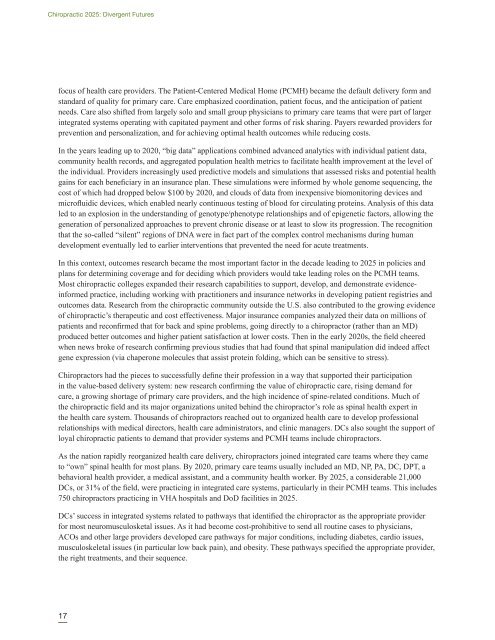Chiropractic 2025:
Chiropractic 2025:
Chiropractic 2025:
Create successful ePaper yourself
Turn your PDF publications into a flip-book with our unique Google optimized e-Paper software.
<strong>Chiropractic</strong> <strong>2025</strong>: Divergent Futures<br />
focus of health care providers. The Patient-Centered Medical Home (PCMH) became the default delivery form and<br />
standard of quality for primary care. Care emphasized coordination, patient focus, and the anticipation of patient<br />
needs. Care also shifted from largely solo and small group physicians to primary care teams that were part of larger<br />
integrated systems operating with capitated payment and other forms of risk sharing. Payers rewarded providers for<br />
prevention and personalization, and for achieving optimal health outcomes while reducing costs.<br />
In the years leading up to 2020, “big data” applications combined advanced analytics with individual patient data,<br />
community health records, and aggregated population health metrics to facilitate health improvement at the level of<br />
the individual. Providers increasingly used predictive models and simulations that assessed risks and potential health<br />
gains for each beneficiary in an insurance plan. These simulations were informed by whole genome sequencing, the<br />
cost of which had dropped below $100 by 2020, and clouds of data from inexpensive biomonitoring devices and<br />
microfluidic devices, which enabled nearly continuous testing of blood for circulating proteins. Analysis of this data<br />
led to an explosion in the understanding of genotype/phenotype relationships and of epigenetic factors, allowing the<br />
generation of personalized approaches to prevent chronic disease or at least to slow its progression. The recognition<br />
that the so-called “silent” regions of DNA were in fact part of the complex control mechanisms during human<br />
development eventually led to earlier interventions that prevented the need for acute treatments.<br />
In this context, outcomes research became the most important factor in the decade leading to <strong>2025</strong> in policies and<br />
plans for determining coverage and for deciding which providers would take leading roles on the PCMH teams.<br />
Most chiropractic colleges expanded their research capabilities to support, develop, and demonstrate evidenceinformed<br />
practice, including working with practitioners and insurance networks in developing patient registries and<br />
outcomes data. Research from the chiropractic community outside the U.S. also contributed to the growing evidence<br />
of chiropractic’s therapeutic and cost effectiveness. Major insurance companies analyzed their data on millions of<br />
patients and reconfirmed that for back and spine problems, going directly to a chiropractor (rather than an MD)<br />
produced better outcomes and higher patient satisfaction at lower costs. Then in the early 2020s, the field cheered<br />
when news broke of research confirming previous studies that had found that spinal manipulation did indeed affect<br />
gene expression (via chaperone molecules that assist protein folding, which can be sensitive to stress).<br />
Chiropractors had the pieces to successfully define their profession in a way that supported their participation<br />
in the value-based delivery system: new research confirming the value of chiropractic care, rising demand for<br />
care, a growing shortage of primary care providers, and the high incidence of spine-related conditions. Much of<br />
the chiropractic field and its major organizations united behind the chiropractor’s role as spinal health expert in<br />
the health care system. Thousands of chiropractors reached out to organized health care to develop professional<br />
relationships with medical directors, health care administrators, and clinic managers. DCs also sought the support of<br />
loyal chiropractic patients to demand that provider systems and PCMH teams include chiropractors.<br />
As the nation rapidly reorganized health care delivery, chiropractors joined integrated care teams where they came<br />
to “own” spinal health for most plans. By 2020, primary care teams usually included an MD, NP, PA, DC, DPT, a<br />
behavioral health provider, a medical assistant, and a community health worker. By <strong>2025</strong>, a considerable 21,000<br />
DCs, or 31% of the field, were practicing in integrated care systems, particularly in their PCMH teams. This includes<br />
750 chiropractors practicing in VHA hospitals and DoD facilities in <strong>2025</strong>.<br />
DCs’ success in integrated systems related to pathways that identified the chiropractor as the appropriate provider<br />
for most neuromusculosketal issues. As it had become cost-prohibitive to send all routine cases to physicians,<br />
ACOs and other large providers developed care pathways for major conditions, including diabetes, cardio issues,<br />
musculoskeletal issues (in particular low back pain), and obesity. These pathways specified the appropriate provider,<br />
the right treatments, and their sequence.<br />
17


